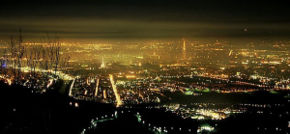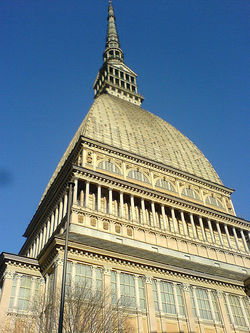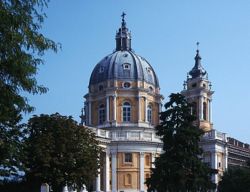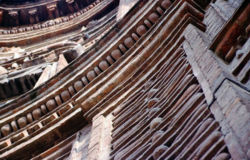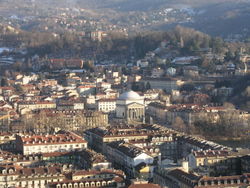Turin
2007 Schools Wikipedia Selection. Related subjects: European Geography
| Comune di Torino | |
|---|---|
 Municipal coat of arms |
|
| Country | |
| Region | Piedmont |
| Province | Turin (TO) |
| Mayor | Sergio Chiamparino ( The Union) |
| Elevation | 240 m |
| Area | 130 km² |
| Population | |
| - Total (as of December 31, 2004) | 902,255 |
| - Density | 6928/km² |
| Time zone | CET, UTC+1 |
| Coordinates | |
| Gentilic | Torinesi |
| Dialing code | 011 |
| Postal code | 10100 |
| Patron | St. John the Baptist |
| - Day | June 24 |
| Website: www.comune.torino.it | |
Turin ( Italian: Torino; Piedmontese: Turin) is a major industrial city as well as a business and cultural centre in northwest Italy, capital of the Piedmont region, located mainly on the west bank of the Po River. The population of the city of Turin is 908,000 ( 2004 census); its metropolitan area totals about 1.7 million inhabitants. The province is one of the largest in Italy, with 6,830 km² (2,637 sq. mi), and one of the most populous, with 2,236,941 inhabitants at the 2004 census. Turin is well-known as the home of the Shroud of Turin, headquarters of Fiat automobile manifacturer and host of the 2006 Winter Olympics. It was the first capital of Italy.
History
The name of Turin comes from Tau, a Celtic word that means mountains. Its Italian name, Torino, translates as "little bull"; hence the coat of arms and the symbol of the city. The area was settled by the Taurini in pre-Roman times.
In the 1st century BC (probably 28 BC), the Romans created a military camp (Castra Taurinorum), later dedicated to Augustus (Augusta Taurinorum). The typical Roman street grid can still be seen in the modern city. Turin reached about 5,000 inhabitants at the time, all living inside the high walls.
After the fall of the Roman empire the city was conquered by the Lombards, then the Franks; in 942 the Contea di Torino ("Countship of Turin"), was founded, since 1050 held by the family of the (then) Counts of Savoy. While the dignity of count was held by the Bishop as conte di Turino, 1092-1130 and 1136 - 1191, it was ruled as a prince-bishopric by the Bishops. It was a lordship 1230 - 1235 under the Marchese di Monferrato, styled Signore di Torino ('Lord')
At the end of the 13th century, when it was annexed to the Duchy of Savoy, the city already had 20,000 inhabitants. Many of the gardens and palaces were built in the 15th century when the city was redesigned. The University was also founded during this period.
Emanuele Filiberto (Iron Head) made Turin the capital of the Duchy of Savoy in 1563. Piazza San Carlo, via Po and the Royal Palace (Palazzo Reale) were built in this period.
In 1706 the French besieged the city for 117 days without conquering it ( Battle of Turin). After the subsequent Treaty of Utrecht, the Kingdom of Sardinia was annexed to the Duchy of Savoy and the architect Filippo Juvarra began a major redesign of the city. Now the capital of a European kingdom, Turin had about 90,000 inhabitants at the time.
In the 19th century, after brief occupation by Napoleon, the city began to actively pursue the unification of Italy. In 1871, the Fréjus Tunnel was opened, making Turin an important communication node. The city now had 250,000 inhabitants. The Museo Egizio, the Mole Antonelliana, the Gran Madre church and Vittorio Veneto square were built in this period.
In 1861, Turin became the capital of the newly proclaimed United Italy. In 1865 the capital was moved to Florence. (Since 1870 the capital has been Rome.) Turin reacted to the loss of importance by beginning a rapid industrialisation: in 1899 FIAT was founded and Lancia in 1906. The Universal Exposition held in Turin in 1902 is often considered the pinnacle of Art Nouveau design, and the city hosted the Exposition again in 1911. By this time, Turin had grown to 430,000 inhabitants.
After World War I conflicts between workers and industrialists began. The first strikes took place and in 1920 the Lingotto factory was occupied.
After World War II Turin was rapidly rebuilt and its industries greatly developed, which caused waves of immigration, largely from the southern regions of Italy. The population reached 1 million in 1960 and peaked at 1.5 million in 1975. In the 1980s the first industrial crisis hit the city and its population began to decline (and continues to, while the metropolitan area grows). The 2005 population is 908,000.
Turin is also the home city for two of the most popular football clubs in the world: Juventus F.C, founded in 1897 as the first team of the city and the Torino F.C., well known for the glorious and tragic history of the Grande Torino. Torino F.C. celebrated his 100th birthday on the 3rd December 2006.
Law and government
The mayor of Turin is directly elected every 5 years. Sergio Chiamparino, the current mayor, belongs to the centre-left coalition.
See also: List of mayors of Turin
Geography and climate
Turin is located in northwest Italy. It is surrounded on the western and northern front by the Alps and on the southern front by the hills of Monferrato. Four major rivers pass through the city: the Po and two of its tributaries, the Dora Riparia (from the Celtic duria meaning "water," later changed to "Duria Minor" by the Romans), the Stura di Lanzo, and the Sangone.
The Piedmont region is mainly characterised by a continental kind of climate with a considerable range of temperature both daily and annually, since the region is protected from marine influence.
The winters are cold and dry, the summers are cool in the hills and quite hot in the plains. During the winter and autumn months banks of fog, which are sometimes very thick, form in the plains.
Within these limits the climate can be divided into three types: the alpine climate, the Padano climate and the peripheral Piedmontese climate.
As regards the average temperatures recorded in the area, the climate is not directly related to the altitude, given that the wider alpine basins often have average winter temperatures more or less the same as those of the plains and summer averages that are not very different . It is increasingly common for absolute minimum temperatures to be recorded in the plains, in residential areas.
Demographics
The population of Turin only grew by 0.88% during the last 3 years, due to very low birth rates. Around 16.4% of the population is under 14 years of age, while those of retirement age are 18.8%.
The city and its suburban areas have seen an increase in immigration from Europe and other continents. While the inhabitants remain overwhelmingly Italian (96.1%), the city now has large groups of immigrants such as Romanians: 2.3%, Moroccans: 1.5%, Peruvians: 0.5%, Albanians: 0.4%, and others.
Economy
Today the city is a major industrial centre, where the headquarters and main production lines of the car company Fiat are located. The city is home to the Lingotto building, which was at one time the largest car factory in the world, and now houses a convention centre, a concert hall, an art gallery, a shopping centre and a hotel. Other companies founded in Turin are Invicta (1821), Lavazza, Martini, Kappa and the chocolate factory Caffarel.
Turin is also well known for its aerospace industry ( Alenia ). The Multi-Purpose Logistics Modules for the International Space Station were produced in Turin. The future European launcher projects beyond Ariane 5 will also be managed from Turin, by the new NGL company, a subsidiary of EADS (70%) and Finmeccanica (30%).
Turin is also the birthplace of some of the country's main companies, such as Telecom Italia (telecommunications), ( Rai (television), and cinema. Most of these industries have since moved their headquarters to other parts of Italy, but Turin still retains the National Museum of Cinema (in the Mole Antonelliana building).
Transportation infrastructure
The town currently has a large number of rail and road work sites. Although this activity has increased as a result of the 2006 Winter Olympics, parts of it had long been planned. Some of the work sites deal with general roadworks to improve traffic flow, such as underpasses and flyovers, but two projects are of major importance and will change the shape of the town radically.
One is the 'Spina' ('spine') which includes the doubling of a major railroad crossing the town. The railroad previously ran in a trench, which will now be covered by a major boulevard. The town rail station on this line will become the main station of Turin ('Porta Susa').
The other major project is the construction of a subway line based on the VAL system, known as Metrotorino. This project is expected to continue for years and to cover a larger part of the town, but its first phase was finished in time for the Olympic Games (inaugurated on 4 February 2006 and opened to the public the day after). This first leg of the subway system links the nearby town of Collegno with the Porta Susa station in Turin's town centre; the next leg extending the service to the 'Porta Nuova' railway station is expected by June 2007. This underground transportation project has historical importance for Turin, as the town has dreamed of an underground line for decades, the first project dating as far back as the twenties. In fact, the main street in the town centre ('Via Roma') runs atop a tunnel built during the fascist era (when 'Via Roma' was built). The tunnel was supposed to host the underground line but is now used as an underground car park. A project to build an underground system was ready in the seventies, with government funding for it and for similar projects in Milan and Rome; whilst the other two cities went ahead with the projects, Turin local government led by mayor Diego Novelli shelved the proposal as it believed it to be too costly and unnecessary, but that only meant more funding for Rome and Milan.
Main sights
The best known building of the city is the Mole Antonelliana, which houses the National Cinema Museum.
The Palatine Towers are among the best preserved Roman remains in northern Italy.
The Cathedral of St John the Baptist houses the Shroud of Turin, an old linen cloth with an imprint of a man, which is believed by many to be the cloth that covered Jesus in his grave.
The Museo Egizio has the most important collection of Egyptian antiquities in the world after the Cairo Museum.
Turin has buildings of great historical and architectural interest: the Savoy Residences. In addition to the Royal Palace (the official residence of the Savoys until 1865) there are many palaces, residences and castles in the city centre and in the surrounding towns. Turin is home to Palazzo Chiablese, the Royal Armoury, the Royal Library, Palazzo Madama, Palazzo Carignano, Villa della Regina, and the Valentino Castle.
The complex of the Residences of the Royal House of Savoy in Turin and in the nearby cities of Rivoli, Moncalieri, Venaria, Agliè, Racconigi, Stupinigi, Pollenzo and Govone was declared in 1997 a World Heritage Sites by UNESCO.
In the hills overlooking the city is the basilica church of Superga, providing a view of Turin against a backdrop of the snow-capped Alps. The basilica holds the tombs of many of the dukes of Savoy, as well as many of the kings of Sardinia. Superga can be reached by means of the Superga Rack Railway from the suburb of Sassi.
The city was the film set of the 1969 film The Italian Job and Deep Red ( 1975), directed by Italian horror filmmaker Dario Argento.
Universities
- University of Turin ( Università degli Studi di Torino)
- Politecnico di Torino
- Istituto Europeo di Design
Turin World Book Capital
After Alexandria, Madrid, New Delhi, Antwerp and Montreal, Turin has been chosen by UNESCO as World Book Capital for the year 2006. The International Book Fair is one of the most important fairs of its kind in Europe.
From April 2006 to April 2007 Turin will host a festival called "Signs of Writing" that will include a wide array of events, workshops, seminars, debates, and performances.
Sport
Rowing
Turin was the city where the FISA (international rowing federation) was born in 1892.
Football
The city is famous for two very successful football teams: Juventus F.C. (founded 1897), and Torino F.C. (founded 1906).
In 1949, a plane carrying the whole Torino F.C. team (at that time the most important in Europe and known as the Grande Torino) hit the church of Superga, on the Turin hills. Valentino Mazzola (one of the best Italian players of all times), father of Ferruccio and Sandro Mazzola (who were later to become football champions) was among those who died.
Olympic Games
Turin was the host of the 2006 Winter Olympics.
Other international championships hosted
- 1959
- I Summer Universiade
- 1970
- VI Summer Universiade
- 2006
- 37th Chess Olympiad
- World Fencing Championship ( Official site)
- 2007
- Turin will host its first Winter Universiade Games
- 2008
- 23rd European Rhythmic Gymnastics (Callisthenics) Championships
- 2009
- IAAF World Indoor Championships in Athletics
Chocolate
Turin is the birth place of solid chocolate. It was in Turin that, at the end of the 18th century, Mr Doret invented a revolutionary machine that could make solid chocolate (as opposed to drinking chocolate).
Turin chocolate firms produce a typical chocolate, called Gianduiotto , named after Gianduja, a local Commedia dell'arte mask; plus many other kinds of chocolate (italian : cioccolatini), all equally delicious.
Every year the town organizes cioccolaTO', a two-week chocolate festival run with the main piedmontese chocolate producers, such as Venchi and others, as well as some big international companies, such as Lindt & Sprüngli.
Nearby towns
Turin is surrounded by several smaller cities in the Province of Turin such as Grugliasco, Rivoli, Chivasso, Venaria, Settimo Torinese, Orbassano, Moncalieri, Avigliana, Buttigliera Alta, Gassino Torinese, Nichelino, Collegno, Chieri, Ivrea, Pinerolo and others, that make up one of Italy's primary metropolitan areas.
Notable natives
- Giovanni Agnelli (1866-1945) - Founder of FIAT
- Gianni Agnelli (1921-2003) - Chairman director of FIAT and very influential Italian
- Amedeo Avogadro (1776-1856) - Physicist
- Alessandro Baricco (1958) - writer
- Giuseppe Marc'Antonio Baretti (1719-1789) - Critic
- Camillo Benso, count of Cavour - Politician ( Italian unification)
- Norberto Bobbio (1909-2004) - Historian and philosopher
- Arturo Brachetti
- Carla Bruni (1968) - Supermodel
- Pierre Paul Caffarel (1795-1850) - Founder of the first chocolate factory in the world
- Antonio Benedetto Carpano (1764-1815) - Inventor of vermouth and apéritif
- Gabry Ponte - DJ Member of Eiffel 65
- Gigi D'Agostino (1967) - DJ
- Robert Fano (1917-2004) - Engineer
- Galileo Ferraris (1847-1897) - Physicist and electrical engineer
- Sonia Gandhi (1946) - Politician
- Piero Gobetti (1901-1926) - Intellectual
- Joseph Louis Lagrange (1736-1813) - Mathematician
- Vincenzo Lancia (1881-1937) - Sportsman and businessman, founder of Lancia
- Luigi Lavazza (1859-1949) - Inventor and businessman of coffee
- Carlo Levi (1902-1975) - Painter and writer
- Primo Levi (1919-1987) - Philosopher and writer
- Salvador Edward Luria (1912-1991) - Nobel Prize in physiology and medicine
- Alessandro Martini (1812-1905) - Businessman in vermouth industry
- Mau Mau (1991) - Rock band
- Carlo Mollino (1905-1973) - Architect and Designer
- Rita Levi-Montalcini (1909) - Nobel Prize in physiology and medicine
- Adriano Olivetti (1901-1960) - Businessman
- Giuseppe Peano (1858-1932) - Mathematician
- Aurelio Peccei (1908-1984) - Founder of the Club of Rome
- Tullio Regge (1931) - Physicist
- Piero Sraffa (1898-1983) - Influential economist
- Subsonica (1996) - Rock band
- Massimo Taparelli, marquis d'Azeglio (1798-1866) - Statesman, novelist and painter
- Umberto Tozzi (1952) - Singer
- Victor Emmanuel II of Italy (1820-1878) - King of Piedmont and the first King of the united Italy
Notable residents
- Alessandro Del Piero
- Edmondo de Amicis
- St. John Bosco
- Francesco Faà di Bruno
- Italo Calvino
- Gaspare Campari
- Francesco Cirio
- Renato Dulbecco
- Umberto Eco
- Luigi Einaudi
- Erasmus
- Guido Fubini
- Natalia Ginzburg
- Antonio Gramsci
- Cesare Lombroso
- Tulse Luper
- Joseph de Maistre
- Giulio Natta
- Friedrich Nietzsche
- Vilfredo Pareto
- Cesare Pavese
- Jean-Jacques Rousseau
- Emilio Salgari
- Ascanio Sobrero
- Germain Sommeiller
- Elio Vittorini
Twin Cities
 - Chambéry, France
- Chambéry, France - Cologne, Germany
- Cologne, Germany - Detroit, USA
- Detroit, USA - Volgograd, Russia
- Volgograd, Russia - Rotterdam, Nederland
- Rotterdam, Nederland - Esch-sur-Alzette, Luxemburg
- Esch-sur-Alzette, Luxemburg - Liège, Belgium
- Liège, Belgium - Lille, France
- Lille, France - Campo Grande, Brazil
- Campo Grande, Brazil - Córdoba, Argentina
- Córdoba, Argentina - Gaza, Palestinian territories
- Gaza, Palestinian territories - Glasgow, Scotland
- Glasgow, Scotland - Salt Lake City, USA
- Salt Lake City, USA - Haifa, Israel
- Haifa, Israel - Nagoya, Japan
- Nagoya, Japan - Quetzaltenango, Guatemala
- Quetzaltenango, Guatemala - Shenyang, China
- Shenyang, China - Warsaw, Poland
- Warsaw, Poland

